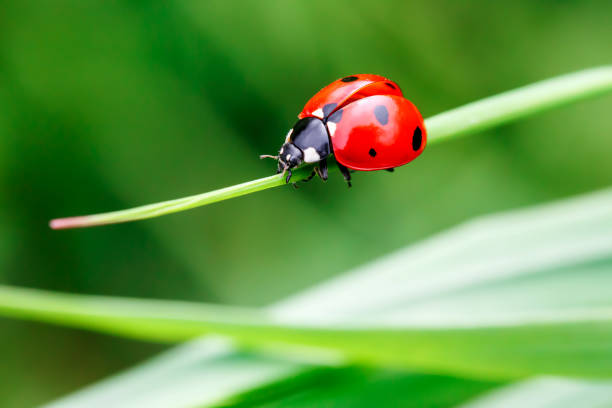What Are Red Insects?
Red insects are a diverse group of bugs that exhibit red hues on their bodies, either partially or entirely. This distinct coloration serves various purposes, including camouflage, warning predators, attracting mates, or regulating temperature. Many red insects are found in gardens, forests, and even homes, playing crucial roles in ecosystems.
Some well-known red insects include:
- Ladybugs (Coccinellidae)
- Red Velvet Ants (Mutillidae, actually a type of wasp)
- Firebugs (Pyrrhocoris apterus)
- Scarlet Lily Beetles (Lilioceris lilii)
- Red Milkweed Beetles (Tetraopes tetrophthalmus)
Their bright coloration makes them a subject of interest for entomologists, nature lovers, and researchers.
Why Are Red Insects Important?
Red insects play essential roles in maintaining ecological balance. Their presence benefits both nature and human activities in several ways:
✔ Pollination – Many red insects help in pollinating flowers, aiding plant reproduction.
✔ Pest Control – Species like ladybugs feed on harmful pests such as aphids.
✔ Soil Health – Certain beetles and ants aerate the soil, promoting plant growth.
✔ Biodiversity Indicators – Their presence often signals a healthy environment.
✔ Scientific Research – Scientists study red insects to understand adaptation and evolution.
Because of these roles, conserving red insect populations is vital for environmental sustainability.
Why Are Red Insects Trending?
Red insects have gained popularity due to their unique appearance, ecological roles, and increasing mentions in scientific discussions. Here’s why they are trending:
📌 Climate Change Studies – Scientists track how these insects adapt to environmental changes.
📌 Gardening & Farming – Farmers and gardeners use ladybugs as natural pest controllers.
📌 Biodiversity Conservation – Growing awareness of insect extinction threats puts red insects in the spotlight.
📌 Photography & Wildlife Enthusiasm – Their vibrant colors attract nature photographers.
📌 Myths & Folklore – Many cultures associate red insects with good luck and prosperity.
As the interest in insect conservation and biodiversity grows, red insects remain a hot topic in research and media.
Types of Red Insects Found in Nature
Red insects can be found worldwide, each species serving unique functions in its habitat. Here are some common types:
1. Ladybugs (Coccinellidae)
- Recognized by their red shells with black spots.
- Beneficial in controlling aphid populations in gardens.
- Symbolizes good luck in many cultures.
2. Firebugs (Pyrrhocoris apterus)
- Found in Europe and Asia, often seen in groups.
- Feeds on seeds of linden and mallow plants.
- Harmless to humans and crops.
3. Red Velvet Ants (Mutillidae)
- Despite their name, they are wasps, not ants.
- Females lack wings and have a painful sting.
- Their red coloration warns predators of their venomous sting.
4. Scarlet Lily Beetles (Lilioceris lilii)
- A major pest for lilies and fritillaries.
- Bright red with a black head and legs.
- Considered invasive in some regions.
5. Red Milkweed Beetles (Tetraopes tetrophthalmus)
- Found in North America, mainly in milkweed plants.
- Their red color signals toxicity to predators.
- Plays a role in plant pollination.
These insects showcase nature’s adaptability and survival mechanisms.
Benefits of Red Insects to Humans and Ecosystems
Red insects provide several advantages that directly and indirectly impact the environment and human life:
1. Environmental Benefits
✔ Natural Pest Control – Predatory red insects reduce the need for chemical pesticides.
✔ Pollination Support – Beetles and bugs help plants reproduce.
✔ Food Chain Stability – Many birds and reptiles rely on red insects as a food source.
2. Agricultural Benefits
✔ Improves Crop Yields – Ladybugs and beetles protect crops from pests.
✔ Enhances Soil Fertility – Insect movement helps with soil aeration.
3. Scientific and Medical Importance
✔ Research on Evolution – Studies on red insects provide insights into color adaptation.
✔ Potential Medicinal Uses – Some insect compounds are being studied for antibacterial properties.
By understanding their benefits, conservation efforts can be made to protect red insect populations.
Why Use Red Insects in Pest Control and Gardening?
Red insects, especially ladybugs and certain beetles, are widely used in organic farming and home gardens. Here’s why they are preferred:
✔ Eco-Friendly Solution – Red insects eliminate pests naturally, reducing pesticide use.
✔ Safe for Plants and Humans – Unlike synthetic chemicals, beneficial insects do not harm crops.
✔ Cost-Effective – Farmers and gardeners can save money by using natural predators.
For those looking to promote a healthy garden ecosystem, introducing red insects is a sustainable and effective method.
How to Attract Red Insects to Your Garden?
Encouraging the presence of red insects can benefit gardens and farms. Here are some ways to attract them:
1. Plant the Right Flowers
- Grow dandelions, marigolds, fennel, and lavender to attract ladybugs and beetles.
2. Avoid Pesticides
- Chemical pesticides can harm beneficial red insects, reducing their population.
3. Provide Shelter
- Use rock piles, logs, and insect hotels to offer safe habitats.
4. Keep a Water Source Nearby
- Small water dishes or damp soil patches help sustain insect populations.
By following these steps, gardeners can maintain a natural balance and encourage beneficial insects to thrive.
Potential Risks and Precautions with Red Insects
Although red insects offer numerous benefits, some can be harmful or invasive. Here are some concerns:
⚠ Some species damage crops – Scarlet Lily Beetles feed on flowers, affecting plant health.
⚠ Painful stings or bites – Red Velvet Ants have a strong sting that causes irritation.
⚠ Overpopulation Issues – If not controlled, certain red insects may disrupt the ecosystem.
Precautions to Take
✔ Identify harmful vs. beneficial red insects before introducing them to your garden.
✔ Wear protective gloves when handling unknown red insects.
✔ Use organic pest control to maintain balance without harming helpful species.
Being mindful of potential risks ensures that red insects are used effectively without unintended consequences.
Conclusion
Red insects are one of nature’s most fascinating creatures, serving essential roles in pollination, pest control, and ecological balance. Their striking colors make them a subject of scientific research, photography, and conservation efforts.
While some red insects are beneficial, others may be harmful, so understanding their role is key to utilizing them effectively. Whether in gardens, farms, or research, these insects continue to captivate scientists and nature enthusiasts alike.
Protecting red insect populations ensures that their ecological contributions remain intact for future generations.
Also Read: Jenkins concerto grosso for strings midi file: Everything You Need to Know
FAQs on Red Insects
Are all red insects poisonous?
No, but many red insects use their coloration to mimic toxicity as a defense mechanism.
Why do red insect have bright colors?
Their color helps with camouflage, attracting mates, or warning predators.
Can red insects be used for farming?
Yes, species like ladybugs are used as natural pest controllers in agriculture.
How can I tell if a red insect is dangerous?
Researching species identification and behavior helps determine if an insect is harmful.
What should I do if I find red insects in my home?
If they are harmless, relocate them outdoors. If they are pests, use natural deterrents.



